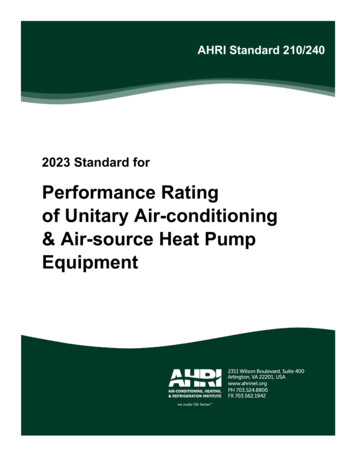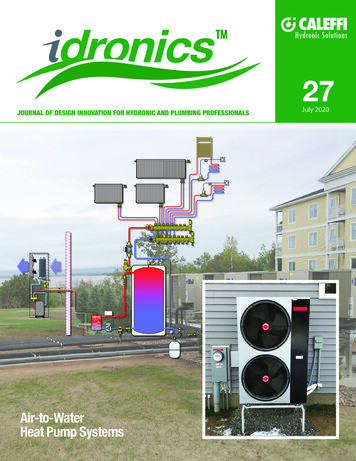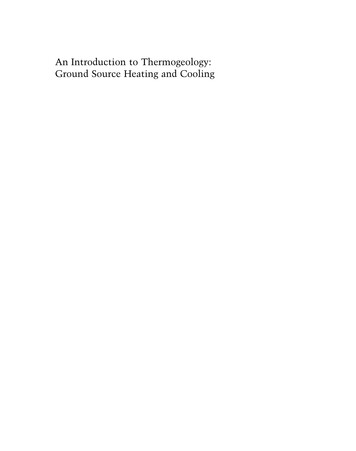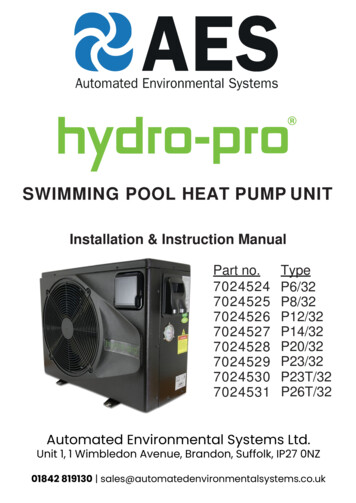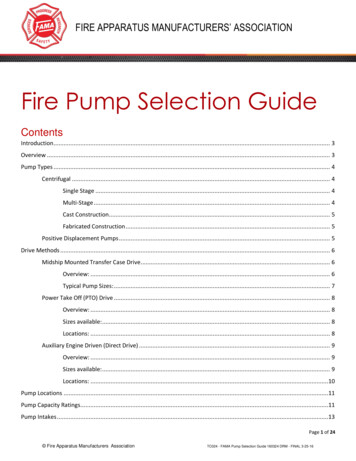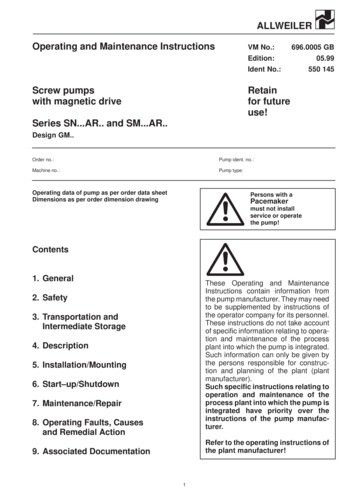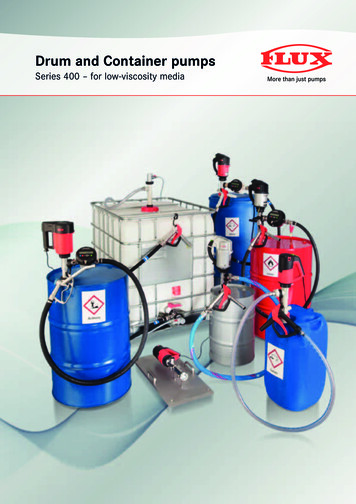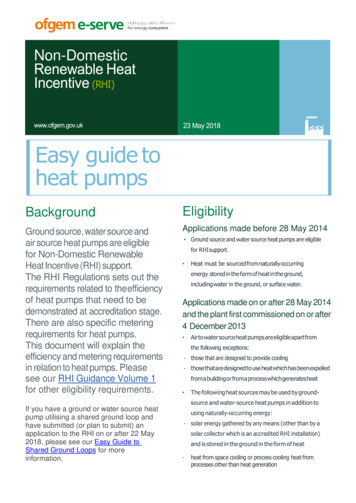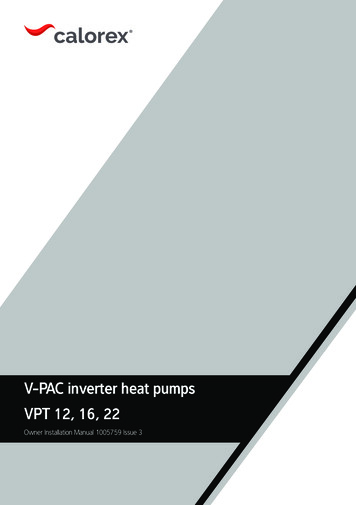
Transcription
Heat pumps: Air to Air, Water to Air, Air to Water,Water or Brine to Water Heat PumpsA guide to equipment eligible for ETL
Contents1. Introduction2. Setting the scene3. Benefits of purchasing ETL-listed products4. Heat pump equipment eligible under the ETL4.1 Packaged Air to Air heat pumps4.2 Air to Water heat pumps4.3 Air to Domestic Hot Water Heat Pumps4.4 Air to Air Heat Pumps, Split, Multi-Split and VRF4.5 Water to Air Heat Pumps, Split, Multi-Split and VRF4.6 Water or Brine to Water Heat Pumps4.7 Heat pump dehumidifiers4.8 Heat pump driven air curtains5. Further information1
1Introduction2
IntroductionThe Energy Technology List (ETL) is a list created and updated monthly by the government’s Department forBusiness, Energy and Industrial Strategy (BEIS), which provides details of energy-saving products forbusinesses. Since its inception, the scheme has assessed nearly 60,000 products, and now features 56technology categoriesTo be listed on the ETL, heat pump products must meet minimum efficiency criteria to be listed on the ETL.This leaflet illustrates the benefits of investing in heat pump equipment which qualifies for the ETL.The ETL comprises two lists: Energy Technology Criteria List: defines the performance criteria that equipment must meet to qualify for the ETL; Energy Technology Product List: is the list of products that have been assessed as being compliant with ETLcriteria.Eligible heat pump products on the ETL can be searched at:https://etl.beis.gov.uk/products/heat-pumpsHeat pump products may also qualify for the renewable heat incentive (RHI) which reduces the cost of thequalifying products for the buyer3
2Setting the Scene4
Setting the scene: Heat PumpsFurther informationFor more information see theCarbon Trust’s Renewableenergy sources guide(CTV010v3).Heat Pump DefinitionA heat pump is a device that can transfer low temperature heat from a renewable source such as ambient air, wateror the ground and raise it to a higher, more useful temperature using a refrigeration cycle. Heat pumps are usuallycategorised by the heat source they use and the heat sink, which can be air, ground or water (eg air to air or brine towater). The majority of heat pump products are air source heat pumps, although the market for ground source heatpumps is growing.The majority of heat pumps sold in the UK have electrically-driven compressors. However, a gas engine can also beused to drive the compressor, in which case the waste heat from the exhaust gases can be collected as useful heat.While some heat pumps are made for heating only, many – especially those using air as the heat source – are alsocapable of providing comfort cooling by reversing the refrigeration cycle. Reversible air source heat pumps may alsobe called reversible air conditioners.In variable refrigerant flow (VRF) products it is possible to vary the flow of refrigerant in the unit, which enablesthem to vary their output to match demand. Some VRF products can provide heating and cooling simultaneouslyand save energy by using heat removed from one part of a building to meet a demand for heat elsewhere.5
Setting the scene: RefrigerantsRefrigerants and their global warming potential (GWP)Refrigerant gases used in heat pumps are more harmful to the environment than CO 2. But that is changing The European Commission considered the environment impact of refrigerant gases to be so significant to the EU’s climategoals that they introduced a phased withdrawal of many existing refrigerants from the market, known as the F-Gasregulation. Since the 1st January 2018 the F-Gas regulation has had a substantial impact of the market, requiring a 37% reduction in theglobal warming impact of refrigerant gases sold in the EU. The reduction is being met through the removal from sale ofrefrigerants with high GWPs such as R404A and R134a. The most common type of refrigerant currently used in heat pumps is R410A, though some lower GWP alternatives exist forsome applications. R32 (GWP 675) is a widely advertised lower GWP refrigerant that is a viable replacement for R410A (GWP2088) in small air-conditioning systems. Some heat pump manufacturers are already leading the market for R32 systems,although this is seen as a transitionary refrigerant due to it’s medium GWP. It is expected that in the future HFO blends mayreplace R32 as a low GWP refrigerant in R410A systems, as is already the case for some ground source heat pumps inScandinavia.When choosing new refrigeration equipment select a product that uses a refrigerant with a medium or low GWP(e.g. R32, R290, R744). Some refrigerants have very low (e.g. R744 CO2) or zero GWP (e.g. R290 propane) Choosing a product that uses a low GWP refrigerant future proofs the investment. It reduces ongoing maintenance costs asthe price for high GWP refrigerants are increasing rapidly (e.g. 800% in 2017). It also avoids the need to refurbish theequipment at a later date to use a lower GWP gases as higher refrigerants gases are removed from the market.6
Standard Vapour Compression Heat Pump CircuitHEAT OUTLIQUIDCONDENSER35 C SUPERHEATEDVAPOURCOMPRESSOREXPANSION VALVELIQUID ANDVAPOUREVAPORATOR-5 C DRYSATURATEDVAPOURHEAT INMost heat pumps use a mechanical vapour compression cycle with the compressor driven by an electric motor.Standard vapour compression heat pumps work by alternately evaporating and condensing a refrigerant. The maincomponents are shown in the figure above and include: an evaporator, a compressor, a condenser, an expansionvalve and a refrigerant such as R410A. Standard heat pumps are able to efficiently provide water flow temperaturesof up to 55 C.Source: t/uploads/system/uploads/attachment data/file/565248/Heat Pumps Combined Summary report - FINAL.pdf7
Measuring heat pump performanceThe steady state performance of a heat pump is measured by the coefficient of performance (COP) which is the ratioof the heating capacity to the effective power input of the unit. The COP is measured in terms of delivered electricity.The seasonal space heating energy efficiency (SSHEE) is a measure of performance averaged across a defined loadprofile, which is designed to represent real life use. SSHEE is measured in primary energy terms allowing comparisonof different technologies using different energy sources.For gas heat pumps, Seasonal Primary Energy Ratio (SPER) is used as a performance measure. This is the ratio of theeffective heating capacity to the total primary energy input (before any conversion or delivery losses, for exampleelectricity generation losses) averaged across the heating season.Typically, for every kWh of energy used to operate an electrically-driven heat pump, the resulting useful heat outputis between 3kWh and 4kWh. Compared with an efficient gas boiler, the use of an electrically-driven heat pump canresult in carbon savings of over 30%. Heat pumps can therefore provide an energy efficient, low carbon form of spaceheating. Furthermore, as the carbon intensity of the UK electricity grid decreases (with increasing uptake of renewableenergy, and eliminating coal fired generation), the carbon savings from heat pumps will increase.Updated from: t/uploads/system/uploads/attachment data/file/565248/Heat Pumps Combined Summary report - FINAL.pdf8
Example PerformanceCarbon emissions per useful KWhoutputEnergy input per useful KWh .20.0500Direct Electric Oil Boiler (0.89eff)Gas Boiler(0.93 eff)Electric HeatPump (3.0 eff)Direct Electric Oil Boiler (0.89eff)Gas Boiler(0.93 eff)Electric HeatPump (3.0 eff)These graphs show a comparison between heat pumps and conventional heating technologies.Energy savings are typically 60% to 70% compared to gas heating with carbon emissions savings ofover 70% compared to oil boilers.The carbon savings are increasing as the electricity grid becomes less carbon intensive.Costs savings vary in relation to the difference between electricity and fuel prices (as well as theheat pump efficiency)Source: ETL research 20219
Common applications for different types of heat pumpsHeat pumps can provide space heating (or heating and cooling) to a wide range of commercial andindustrial buildings. For heating, the lower the required output temperature, the more efficiently a heatpump can operate, so this heating technology is most suitable for air-based heating or low temperaturewater-based heating systems. Specially designed high temperature heat pumps have been developed forapplications that need higher output temperatures.The main air to air heat pump products are single and multi split and packaged rooftop or indoor heatpumps. They are used to provide space heating and cooling to a wide range of commercial buildings, oftenwith VRF, and are also able to provide heat recovery. VRF systems require no ductwork so free up internalspace compared with warm air handling systems.Air to water single and multi split heat pumps are used predominantly in small retail, hospitality andoffices and replace gas condensing boilers. Products can provide additional functions including sanitaryhot water, hydronic heating and air curtains. Packaged products are used for larger retail and leisurepremises with rooftops used where internal space is limited.For small heating systems, a heat pump is an alternative to a conventional gas boiler heating system. Forlarger systems, a heat pump system is generally an alternative to a combination of a gas boiler and a chillerand fan coil units, or renewable heating such as a biomass boiler.10
3Benefits of Purchasing ETL-listedProducts11
Benefits of purchasing ETL-listed productsWhen replacing equipment, businesses are often tempted to opt for equipment with the lowest capitalcost. However, such immediate cost savings may prove to be a false economy. Considering higher energyefficient products, means that life cycle costs are reduced, improving cash flow in the longer term.In addition to the long-term financial savings, upgrading or replacing equipment with high efficiencyproducts on the ETL provide greenhouse gas (GHG) emissions savings through the reduced demand forenergy thereby improving your environmental performance.Developments in heat pump technology, such as advances in heat exchanger design, better capacity controland use of EC fans, mean that efficiencies have improved significantly. However, the energy efficiency ofproducts on the market varies widely.For example, for air to water heat pumps to be listed on the ETL, the Seasonal Space Heating EnergyEfficiency (SSHEE) at 52oC output must be equal to or above 125% for large units ( 45 KW) and 130% forunits smaller than 45 KW. Low-temperature units, producing water temperatures at the outlet of less than52oC need to have a SSHEE value equal to or above 155%.In the 2015 UK product requirements, medium and high temperature heat pumps ( 52oC at outlet) wererequired to have a SSHEE value of 100%. This shows a 30% variation (improvement) in just over 5 years.This variation in efficiency between heat pump products means the potential for reduced running cost,energy consumption and CO2 between different heat pumps can be sizeable and selecting inferior or olderproducts could result in underperformance and a longer payback time.12
4Heat Pump Equipment Eligible Under theETL13
Heat pump equipment eligible under the ETLThere are seven sub-technologies within the heat pumptechnology category included in the ETL:Air source heat pumps Split and multi-split including variable refrigerant flow(VRF) Gas engine-driven split and multi-split including VRF Packaged Heat pumps for domestic hot water heating Air to waterWater to air heat pumps (internal water loop only) Split and multi-split including variable refrigerant flow(VRF)Water or Brine to Water Heat Pumps Brine to water (indirect closed-loop heat exchanger,buried in the ground)Heat pump dehumidifiersHeat pump driven air curtains14
Products eligible under the ETL:Air to Air heat pumps1/2Air source heat pumpsOutdoor air is drawn through a heat exchanger where it is chilled by therefrigeration process and returned to the outdoors. The heat extracted fromthe chilled air is then transferred by the refrigerant and used to providespace heating via a second heat exchanger that circulates indoor air. The ETLincludes air source products using ambient air (but not exhaust air) as theheat source. The heat can be supplied to either air or water.Air to air heat pumps are available in a variety of configurations and manyare reversible units, being capable of both heating and cooling. Figure 1shows an air source heat pump in heating mode.Single (one indoor unit) and multi-split (multiple indoor units) heat pumpsare used predominantly in small retail and offices and replace gascondensing boilers. VRF have been used mainly in large commercial officesand hotels however the capacity range now extends down to under 12 kWso they can also be used for large residential and light commercialapplications.15
Products eligible under the ETL:Air to Air heat pumps2/2Air source heat pumpsSplit and multi-split including VRF‘Split’ type heat pumps have separate heat collection and rejection units foreach space known as ‘outdoor’ and ‘indoor’ units. The ‘outdoor’ and ’indoor’units are specifically designed to be connected together during installationby refrigerant pipework to form a single functional system. VRF heat pumpsare systems specifically designed to automatically adjust the flow ofrefrigerant to each ‘indoor’ unit so that the heat delivered is matched to itsdemand. In particular, one of the ‘indoor’ units of a VRF system could be anair curtain.Gas engine-driven split and multi-split including VRFAir to air gas engine driven (GED) split and multi-split heat pumps use a gasfired internal combustion engine to drive the compressor rather thanelectrical energy.Packaged heat pumps‘Packaged’ type heat pumps are single factory assembled units thatincorporate all the elements of the refrigeration system and air distributionmechanisms for space heating. Packaged products are used for larger retailand leisure with rooftops used where internal space is limited.16
Products eligible under the ETL:Air to Water heat pumps1/2Air to water heat pumpsAir to water heat pumpsAir to water heat pumps are products that are specifically designed totransfer heat from the air outside a building to a water-based heatingsystem, by means of a reverse refrigeration cycle. They may also be used toprovide domestic hot water for sanitary purposes as well as for heating.They are mainly used to provide domestic space heating but can alsoprovide space heating (or space heating and cooling) to a wide range ofcommercial buildings.They are most suitable for use with underfloor heating, fan coils or lowtemperature radiators as the efficiency reduces as the output temperatureincreases. The maximum output temperature for some products is about52 C but many products can now go up to 65 C and can also be used toprovide sanitary hot water. Some commercial products, particularly onesusing CO2 as the refrigerant, just provide sanitary hot water. Potential otheruses include waste heat recovery and industrial process heating17
Products eligible under the ETL:Air to Water heat pumps2/2Installing an ETL compliant air-to-water heat pump with acapacity of 12kW instead of direct replacement of an electricheating boiler of 32 KW, could lead to potential annual savingsof: 2,658 21 MWh 4.9 tonnes CO2With a typical capital cost of 16,000 installed for the heatpumps (compared with 2,500 for a replacement electric boiler)and assuming a 10 year lifetime, the energy saving benefitscould be around 18,743 at today’s prices. It would only take 2.6years to recover the extra capital cost for the heat pump.Further savings and a faster payback may be possible by claimingthe Renewable Heat Incentive, local grants, or signing up to timeof use tariffs.Compared to direct electric heating, energy and carbon emissionsavings will both be typically over 62%.An ETL listed heat pump must meet defined energyefficiency levels under various load conditions. In thiscase study, the baseline scenario below has been usedto calculate the potential financial ( ), energy (kWh)and carbon savings (tonnes CO 2) unless otherwiseindicated: Annual heating utilisation: 1,080 equivalent hours atfull capacity. Price for electricity 12.66p/kWh Carbon emissions for electricity 0.233 kgCO2/kWh Electric boiler efficiency is 100% ETL listed products are presumed to be in the top25% of energy efficient products available in themarketplace. For Air to Water Heat Pumps this translates into aSeasonal Coefficient of Performance of 3.33 The annual increase in electricity cost is assumed tobe equal to the discount factor (inflation) applied tothe capital costEnergy cost and emissions data from BEIS 202018
Products eligible under the ETL:Water to Air heat pumps1/2Water to air heat pumpsWater source heat pumps, as the term implies, obtain and relinquish heat from a water source. For the purposeof products listed in the ETL, this means a circulating water loop within a building.Frequently installed as a means of balancing heat load demand, water to air heat pumps are an integratedheating/cooling solution to mixed mode operation in large commercial buildings and offices. Whilst air-to-airVRF systems are used in similar applications to provide heating and cooling, for larger buildings water sourceheat pumps can provide a more suitable and cost effective solution.The water loop is equipped with a source of make up heat and a method of rejecting excess waste heat tocover conditions when the demands for heating and cooling are not balanced. These are usually a small boilerand an externally mounted dry cooler or an evaporative condenser, but can also be an air-to-water or groundto-water heat pump.Water loop systems are free to modulate between heating and cooling, and exploit the tendency of somecommercial premises to spend a high proportion of their operating time in a state of near equilibrium. Heat isemitted from internal cooling processes at approximately the same rate that heat is required for heatingelsewhere in the building.The water loop effectively transfers what would otherwise be waste heat to part of the building where it can beused. Excess heat from one room may be removed by local cooling by a heat pump unit. The heat is rejectedinto the water loop and may be used by another heat pump in another part of the building that requires heat.This is a cost-effective way of transferring useful heat and is an alternative to rejecting the heat outside thebuilding, as would be the case with a conventional cooling unit. Only split, multi-split and VRF units are includedon the ETL.19
Products eligible under the ETL:Water to Air heat pumps2/2Water to air heat pumpsSplit water source VRF unitsA water source VRF unit is an alternative to many small packaged watersource units throughout the building. The VRF units are connected to theinternal water loop.Heating and cooling is provided to the space by split indoor units connectedto the VRF units with refrigerant lines and electrical controls, in the sameway as a conventional air-to-air heat pump. The indoor units are available ina variety of configurations and capacity sizes, selected to suit the buildingdesign requirements. They are used to provide space heating or cooling tocommercial buildings. VRF are suitable for large buildings with simultaneousdemands for heating and cooling .Water source VRF heat pumps using an internal water loop as a heat sourceThe temperature of the water circulated within the loop is kept withinpredetermined limits.Fuel savings from installing an ETL listed water source VRF heat pumpcompared to a typical non-eligible product are at least 25% greater.20
Products eligible under the ETL:Water or Brine to Water Heat Pump1/3Water or Brine to Water Heat PumpWater or Brine to Water Heat Pump systems are specifically designed to transfer heat from the ground or asurface water source to a water-based heating system by means of a refrigeration cycle. The liquid heattransferring medium for the heat pump may be brine or water.The ground is a reliable and predictable source of stored solar energy. Below a depth of about 6m the groundtemperature remains almost constant throughout the year, staying between 10 C and 14 C, depending on thelocation and the local geology. Heat pumps using underground aquifers as the heat source are also eligible forthe ETL within the Water or brine to water heat pump technology category.Pipes are buried either horizontally in a shallow trench at a depth of between 0.6m and 2.0m, or vertically inone or more boreholes between 15m and 180m in depth (always required for underground aquifer source heatpumps). The size and configuration of the collectors are dependent on the heat load, the type of the groundand how much is available for use.Water or Brine to Water Heat Pumps use an electrically operated refrigeration system to transfer heat from theground or surface water into a water-based heating system. They can be used to provide space heating in awide range of buildings, and some products may be also able to provide cooling by reversing the refrigerationcycle within the product.21
Products eligible under the ETL:Water or Brine to Water Heat Pump2/3Water or Brine to Water Heat PumpWhile initial ground-work costs are higher than for air source heat pumps ofan equivalent capacity, capacity losses through periodic defrost are avoidedand the efficiency can be much higher, especially during winter monthswhen heating is needed most.Only ground source heat pumps designed to deliver heat to water basedheating systems are eligible for the ETPL.Energy savings from installing an ETL listed ground source heat pumpcompared to a typical non-specified product are typically 10% to 18%.Providing space heating using an ETL listed brine-to-water heat pumpinstead of a gas boiler could reduce carbon emissions by over 50%.Brine to Water heat pumpsIn a brine to water heat pump, the heat is collected from the ground orsurface water by circulating a solution of water and anti-freeze (known as‘brine’) through a buried or submerged, closed-loop, ground heat exchanger.Water to Water heat pumpsIn a water to water heat pump, the heat is collected from ground water(aquifer) or surface water by circulating the water through a direct, openloop heat exchanger.22
Products eligible under the ETL:Water or Brine to Water Heat Pump3/3Water or Brine to Water Heat PumpTransfer mediumGround and surface water source heat pumps use either brine or water as the heat transfer medium that iscirculated through the pipes. Ground source heat pumps typically circulate a water/anti-freeze mixture (brine)through a closed loop of pipes. Surface water heat pumps may use water or brine and aquifers typically usewater.Open and closed loop systemsGround source heat pumps are typically self-contained units that may be installed either internally or externallyaccording to the type of unit selected. Two independent sealed secondary circuits circulate low-temperaturebrine through the ground in a closed system and hot water through the internal circuits respectively.Surface water source heat pumps typically use an open loop system, where the water is extracted directly fromthe source and circulated through the heat pump, before being returned to the body of surface water.Alternatively, a closed loop system can be used whereby brine or water is circulated through the water sourcewithin a closed loop pipe. Using an open loop system can result in higher efficiencies, although maintenanceand the impact on the water source can be higher.23
Products eligible under the ETL:Heat pump dehumidifiersHeat pump dehumidifiersA heat pump dehumidifier removes water vapour from moist air using refrigerationtechnology.They can be used to improve personal comfort, protect building fabric and storedgoods, and dry industrial products. They are also well suited to leisure centres or hotelswith swimming pools. Moist air from the space is drawn through a heat exchangerwhere it is chilled by the refrigeration process, and the resulting condensate is drainedaway. The sensible heat extracted from the air and the latent heat of condensation ofthe water is then transferred by the refrigerant and used to reheat the air via a secondheat exchanger before the dry, warmed air is returned to the space. Any excess heatnot required to heat the space can be used for other purposes such as water heating.Products can consist of a single package or two or more factory-built sub-assembliesdesigned to be connected during installation.Only heat pump dehumidifiers designed for permanent installation within the building(i.e. not portable units) and which have a dehumidification capacity greater than orequal to 0.625 litres/hour are eligible for inclusion on the ETL. Fuel savings from an ETLheat pump dehumidifier compared to a typical non-specified product are around 10%.Where heat pump dehumidifiers are used to replace alternative technologies forproviding dehumidification such as ventilation and heating, savings can be considerablygreater.24
Products eligible under the ETL:Heat pump driven air curtainsHeat pump driven air curtainsHeat Pump Driven Air Curtains are products fitted above a doorway or similar opening that are specificallydesigned to reduce the infiltration of air from one space to another, and that is heated and/or cooled by a heatpump that transfers heat by means of a refrigeration cycle.Air curtains are used to reduce losses by disrupting the natural convection between two adjacent spaces thatare at differing temperatures, thereby reducing the amount of heating or cooling needed to maintain thetemperature of a space. They are typically used in commercial premises for situations where an open door isrequired to allow uninterrupted access or where traffic through the doorway is so high that the door is open forextended periods. Heat pump driven air curtains use a heat pump to heat or cool the air curtain expelled by theproduct. This reduces the need to heat the air directly with electricity or heat derived from other fuels.The ETL aims to encourage the purchase of higher efficiency split type heat pump driven air curtains, whichhave separate heat collection and rejection units for each space known as ‘indoor’ and ‘outdoor’ units. The‘indoor’ and ‘outdoor’ units are specifically designed to be connected together during installation by refrigerantpipework to form a single functional unit.Within the Heat pump driven air curtains technology category, the ETL covers air curtains driven by eithersingle-split or multi-split heat pumps.25
5Further Information26
Renewable Heat Incentive (RHI)Some heat pumps (ground source, water source and air source) are eligible for the RHI.The RHI is a UK Government scheme which helps businesses, public sector and non-profit organisationsmeet the cost of installing renewable heat technologies. Payments are made over 20 years and are basedon the heat output of your system.The RHI is a current financial support mechanism to reduce the cost burden for high efficiency andrenewable heating products. There are certain requirements for eligibility for the RHI, such as the heatpump units being less than 45 KW (for a single unit), and that the heat pump product is being used for bothspace heating and water heating, or just space heating.For more information on the RHI, such as tariffs, qualifying technologies and guidance please follow thislink to the UK Government RHI page.For guidance on applying for the RHI, please follow this link.27
Where can I find more information?For information about the ETL please visit: https://www.gov.uk/guidance/energy-technology-list andsee our Information for Purchasers factsheet. Or contact the ETL Help Line on 0300 330 0657For more information on the ETL:To search for a product on the ETL please visit:https://etl.beis.gov.uk/engetl/fox/live/ETL PUBLIC PRODUCT SEARCHThis pack has been prepared by the Carbon Trust for BEIS. Whilst reasonable steps have been taken to ensure the information contained withinthis publication is correct, BEIS, the Carbon Trust, its agents, contractors and sub-contractors give no warranty and make no representation as toits accuracy and accept no liability for any errors or omissions. Crown copyright 2021You may re-use this information (not including logos) free of charge in any format or medium, under the terms of the Open GovernmentLicence.To view this licence, visit cence/ or write to the Information Policy Team, TheNational Archives, Kew, London TW9 4DU, or email: psi@nationalarchives.gsi.gov.uk.28
Heat pump equipment eligible under the ETL 4.1 Packaged Air to Air heat pumps 4.2 Air to Water heat pumps 4.3 Air to Domestic Hot Water Heat Pumps 4.4 Air to Air Heat Pumps, Split, Multi-Split and VRF 4.5 Water to Air Heat Pumps, Split, Multi-Split and VRF 4.6 Water or Brine to Water Heat Pumps 4.7 Heat pump dehumidifiers 4.8 Heat pump driven .
